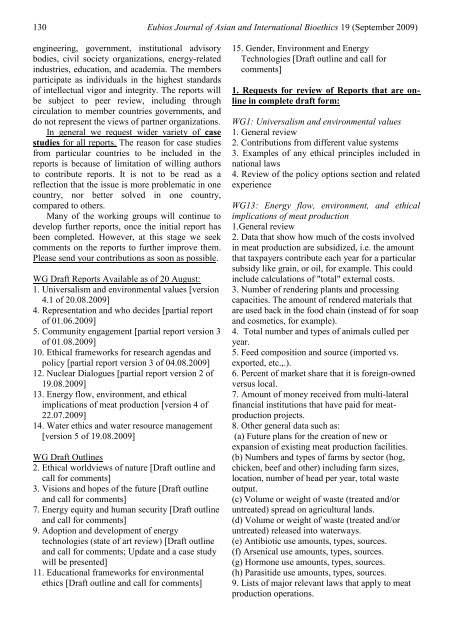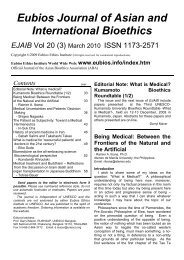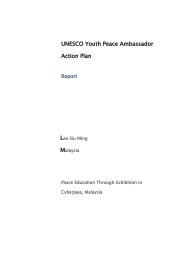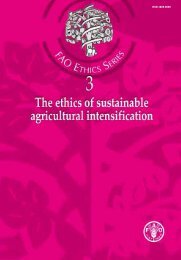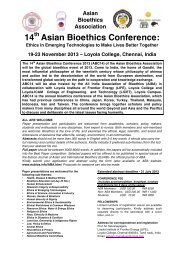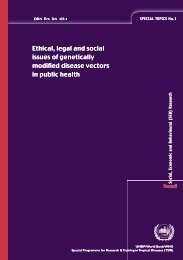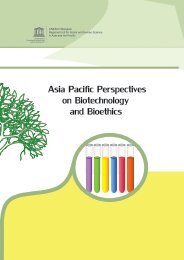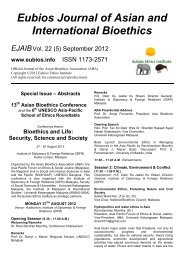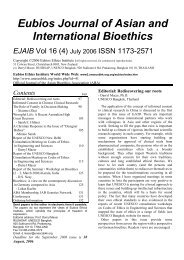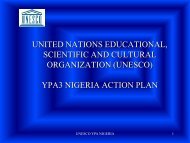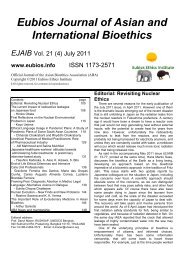Eubios Journal of Asian and International Bioethics EJAIB
Eubios Journal of Asian and International Bioethics EJAIB
Eubios Journal of Asian and International Bioethics EJAIB
You also want an ePaper? Increase the reach of your titles
YUMPU automatically turns print PDFs into web optimized ePapers that Google loves.
130 <strong>Eubios</strong> <strong>Journal</strong> <strong>of</strong> <strong>Asian</strong> <strong>and</strong> <strong>International</strong> <strong>Bioethics</strong> 19 (September 2009)<br />
engineering, government, institutional advisory<br />
bodies, civil society organizations, energy-related<br />
industries, education, <strong>and</strong> academia. The members<br />
participate as individuals in the highest st<strong>and</strong>ards<br />
<strong>of</strong> intellectual vigor <strong>and</strong> integrity. The reports will<br />
be subject to peer review, including through<br />
circulation to member countries governments, <strong>and</strong><br />
do not represent the views <strong>of</strong> partner organizations.<br />
In general we request wider variety <strong>of</strong> case<br />
studies for all reports. The reason for case studies<br />
from particular countries to be included in the<br />
reports is because <strong>of</strong> limitation <strong>of</strong> willing authors<br />
to contribute reports. It is not to be read as a<br />
reflection that the issue is more problematic in one<br />
country, nor better solved in one country,<br />
compared to others.<br />
Many <strong>of</strong> the working groups will continue to<br />
develop further reports, once the initial report has<br />
been completed. However, at this stage we seek<br />
comments on the reports to further improve them.<br />
Please send your contributions as soon as possible.<br />
WG Draft Reports Available as <strong>of</strong> 20 August:<br />
1. Universalism <strong>and</strong> environmental values [version<br />
4.1 <strong>of</strong> 20.08.2009]<br />
4. Representation <strong>and</strong> who decides [partial report<br />
<strong>of</strong> 01.06.2009]<br />
5. Community engagement [partial report version 3<br />
<strong>of</strong> 01.08.2009]<br />
10. Ethical frameworks for research agendas <strong>and</strong><br />
policy [partial report version 3 <strong>of</strong> 04.08.2009]<br />
12. Nuclear Dialogues [partial report version 2 <strong>of</strong><br />
19.08.2009]<br />
13. Energy flow, environment, <strong>and</strong> ethical<br />
implications <strong>of</strong> meat production [version 4 <strong>of</strong><br />
22.07.2009]<br />
14. Water ethics <strong>and</strong> water resource management<br />
[version 5 <strong>of</strong> 19.08.2009]<br />
WG Draft Outlines<br />
2. Ethical worldviews <strong>of</strong> nature [Draft outline <strong>and</strong><br />
call for comments]<br />
3. Visions <strong>and</strong> hopes <strong>of</strong> the future [Draft outline<br />
<strong>and</strong> call for comments]<br />
7. Energy equity <strong>and</strong> human security [Draft outline<br />
<strong>and</strong> call for comments]<br />
9. Adoption <strong>and</strong> development <strong>of</strong> energy<br />
technologies (state <strong>of</strong> art review) [Draft outline<br />
<strong>and</strong> call for comments; Update <strong>and</strong> a case study<br />
will be presented]<br />
11. Educational frameworks for environmental<br />
ethics [Draft outline <strong>and</strong> call for comments]<br />
15. Gender, Environment <strong>and</strong> Energy<br />
Technologies [Draft outline <strong>and</strong> call for<br />
comments]<br />
1. Requests for review <strong>of</strong> Reports that are online<br />
in complete draft form:<br />
WG1: Universalism <strong>and</strong> environmental values<br />
1. General review<br />
2. Contributions from different value systems<br />
3. Examples <strong>of</strong> any ethical principles included in<br />
national laws<br />
4. Review <strong>of</strong> the policy options section <strong>and</strong> related<br />
experience<br />
WG13: Energy flow, environment, <strong>and</strong> ethical<br />
implications <strong>of</strong> meat production<br />
1.General review<br />
2. Data that show how much <strong>of</strong> the costs involved<br />
in meat production are subsidized, i.e. the amount<br />
that taxpayers contribute each year for a particular<br />
subsidy like grain, or oil, for example. This could<br />
include calculations <strong>of</strong> "total" external costs.<br />
3. Number <strong>of</strong> rendering plants <strong>and</strong> processing<br />
capacities. The amount <strong>of</strong> rendered materials that<br />
are used back in the food chain (instead <strong>of</strong> for soap<br />
<strong>and</strong> cosmetics, for example).<br />
4. Total number <strong>and</strong> types <strong>of</strong> animals culled per<br />
year.<br />
5. Feed composition <strong>and</strong> source (imported vs.<br />
exported, etc.,.).<br />
6. Percent <strong>of</strong> market share that it is foreign-owned<br />
versus local.<br />
7. Amount <strong>of</strong> money received from multi-lateral<br />
financial institutions that have paid for meatproduction<br />
projects.<br />
8. Other general data such as:<br />
(a) Future plans for the creation <strong>of</strong> new or<br />
expansion <strong>of</strong> existing meat production facilities.<br />
(b) Numbers <strong>and</strong> types <strong>of</strong> farms by sector (hog,<br />
chicken, beef <strong>and</strong> other) including farm sizes,<br />
location, number <strong>of</strong> head per year, total waste<br />
output.<br />
(c) Volume or weight <strong>of</strong> waste (treated <strong>and</strong>/or<br />
untreated) spread on agricultural l<strong>and</strong>s.<br />
(d) Volume or weight <strong>of</strong> waste (treated <strong>and</strong>/or<br />
untreated) released into waterways.<br />
(e) Antibiotic use amounts, types, sources.<br />
(f) Arsenical use amounts, types, sources.<br />
(g) Hormone use amounts, types, sources.<br />
(h) Parasitide use amounts, types, sources.<br />
9. Lists <strong>of</strong> major relevant laws that apply to meat<br />
production operations.


